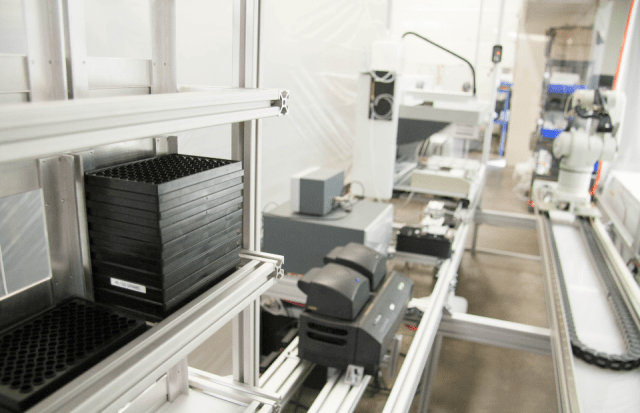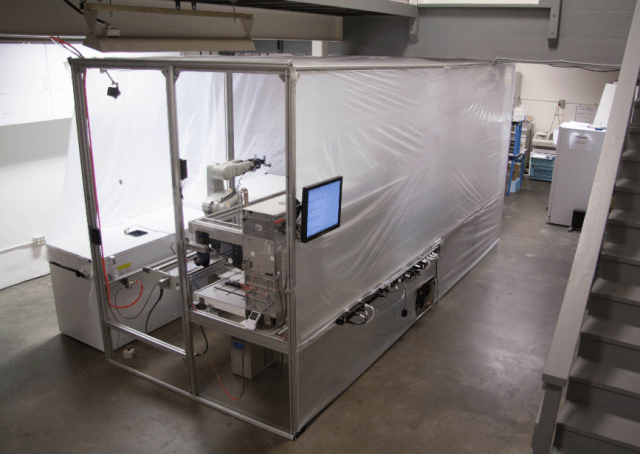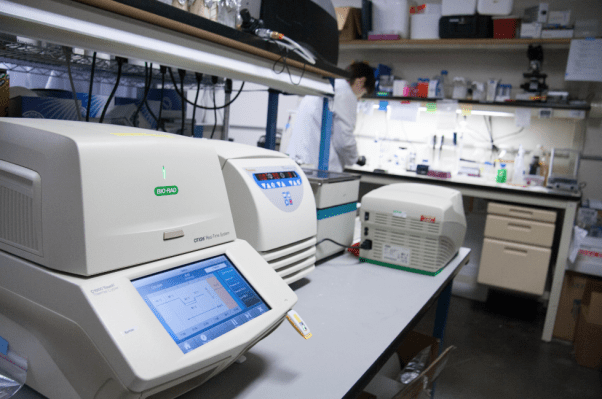As a biomedical engineering student at Duke, Max Hodak became intimately familiar with the sterile tedium of life in a research lab. Like many others who’ve spent wasted hours of their lives in white coats, he found the fact that most labs still look and operate as they did thirty years ago frustrating. Beyond the fact that many labs are disconnected and aren’t networked, research itself remains a manual, hands-on process, involving a lot of moving small amounts of liquid from one tube to another or handling petri dishes.
Watching researchers spend so much time waiting around to use one machine or another, and navigating a manual process where mistakes are both easy to make and costly, Hodak came to the conclusion that labs could use a little automation — and a few more robots. A programmer since age six, the biology student decided to engineer a solution and give life sciences its own, custom version of Amazon Web Services.
The result is Transcriptic, a startup and service provider that aims to make the day-in-day-out process of wet lab biology research faster, cheaper and more accessible. Basically, Transcriptic is Science-as-a-Service — or, in other words — a software and robot-enabled remote lab, which uses automation and control technology to perform studies and trials in less time than your average bear, er, Contract Research Organization (or CRO).
In today’s life sciences, CROs are the only option for those in need of third-party support for clinical testing and research, and, as such, now represent a multi-billion dollar industry. With its technology and services, Transcriptic is, in a way, looking to play the role of CRO 2.0 and reverse the traditionally lengthy sales process, slow turnarounds and high prices endemic among the industry’s incumbents.
Part of Transcriptic’s big goal is the total virtualization and automation of the life sciences research funnel, in particular its infrastructure, and the startup has collected its own fleet of robotic equipment, machines, high-powered microscopes, incubators and centrifuges in its Menlo Park lab to help it do just that. With money being tight in the early development, the team cobbled together this equipment, buying much of it on the cheap, and re-writing software for the machines that enables them to be controlled via its automated command system.
However, in spite of its virtualization mission and the fact that submitted protocols are handled by its “automated workcells,” Transcriptic is not without its human components. Transcriptic has a team of “qualified PhD scientists and engineers” to oversee the “functionality of the workcell through internal controls and monitoring,” the company says. In reality, the robot to human ratio is closer to 50:50, Hodak says.
Instead, the lab, company or researchers that want to run their experiments through Transcriptic send them detailed instructions on what they want to test for, control for, and so on. The startup plays no role in the design, interpretation or analysis, and doesn’t control environmental parameters other than temperature and humidity.
Although it does offer to work with companies to debug and figure out the right approach to make projects work, the founder says. Then, after experiments are completed, the data shows up in the user’s dashboard, and Transcriptic mails them their samples.
As of now, the company offers packaged services for cloning and mouse genotyping experiments, as well as growth curve analysis and safe freezer storage via its biobanking program. Each service is priced differently, with most based on a pay-as-you-go-style system. Cloning includes a base fee, while the others are priced “per reaction.”
The idea, in Hodak’s conception, is to bring both the cloud computing and the pricing schema of the enterprise software and SaaS markets to science, and in so doing, significantly undercut the prices of the traditional CROs. The other motivator for the Transcriptic founder is to enable biology and life science to focus on the part of it that humans should control — creating hypotheses, doing analysis and designing experiments — while leaving the manual leg-work to robots and technology.
Of course, all of the above is much easier said than done. After all, when you get down to it, biology research, cloning, genotyping, and experimentation in every area in between is all about precision. Reliability, and producing trustworthy, reliable results is key. Furthermore, for some, the manual tasks inherent to testing, tweaking and experimenting are an important part of the process, and many scientists (especially those over a certain age) are loathe to the idea of outsourcing the research process — especially to a startup.

In part, the latter point explains why, at least in the early-stages, Transcriptic has been finding more ready converts among grad students and younger members of the scientific community, who, Hodak says, quickly understand the company’s value proposition. That being said, even if “younguns” make up the core of its user base, it’s not as if these younguns are bottom of the barrel-type scientists or working out of labs one might find on Breaking Bad. Today, Transcriptic counts researchers at Stanford, Caltech, UCSD, Harvard, MIT and the University of Chicago among its customers.
Certainly, the startup still has a battle in front of it to convince scientists they can trust a startup for fast, reliable and affordable results, though its case can improve as it collects more data, the founder says. Plus, when you get down to it, what lab wouldn’t like to be able to run more experiments in less time? By making this (theoretically) possible, and by pointing to the larger, macro trend of medical and life science companies and processes moving to the cloud, the core concept becomes less frightening.
These are among the selling points Transcriptic has been using to curry favor among venture capitalists as well — a group that is apparently in need of some serious convincing these days when it comes to life science investing. A recent report from PricewaterhouseCoopers found that life sciences lagged behind most industries as a recipient of venture investment in 2013 — both in terms of the amount invested and the number of deals.
In a sign of validation for the biotech startup, while VCs are shying away from life science investment, Transcriptic quietly closed a $1.2 million round of seed financing in 2012, which was led by Google Ventures, with support from Founders Fund’s seed investment vehicle as well as angels one doesn’t typically find on a biotech investor roster, like Mark Cuban and Naval Ravikant.
And now, with a business that Hodak says has been doubling every month since October, investors are going against the trend and doubling down on Transcriptic. The startup added another $2.8 million in this week in a round led by IA Ventures — with IA’s Brad Gillespie joining its board — along with additional support from Google Ventures, AME Cloud Ventures, Data Collective and Boost.vc. The round brings Transcriptic’s total funding raised to date to $4.1 million.
With the new capital under its belt, Transcriptic has big product plans in its sights, and although Hodak declined to share too many details, it looks as if the startup is moving to expand its services and research coverage. On top of that, Transcriptic is eager to grow its team and invest in more equipment. Life Sciences hardware can be a hard sell for some VCs, but the company has managed to remain lean (like building a freezer for $8K which Hodak told the Verge would have cost $400K retail) and, if it’s able to follow through (even in part) with its mission to help change how research is done, has big implications.
Plus, as Transcriptic’s “About Us” page reads: “We want seed incubators to fund biotech companies composed of two graduate students and a laptop, not social-local-mobile photo-sharing apps.” For supporters of life science — and, hey, science in general — that’s a goal that’s easy to get behind.
For more, find Transcriptic at home here.

